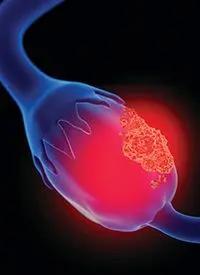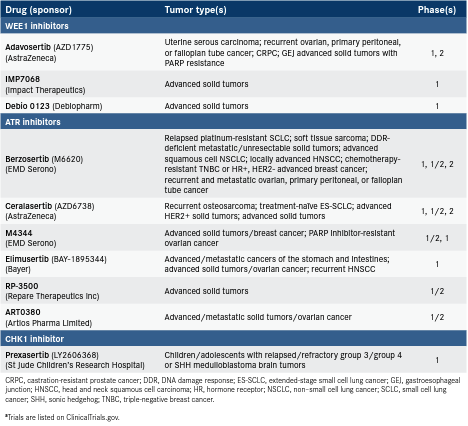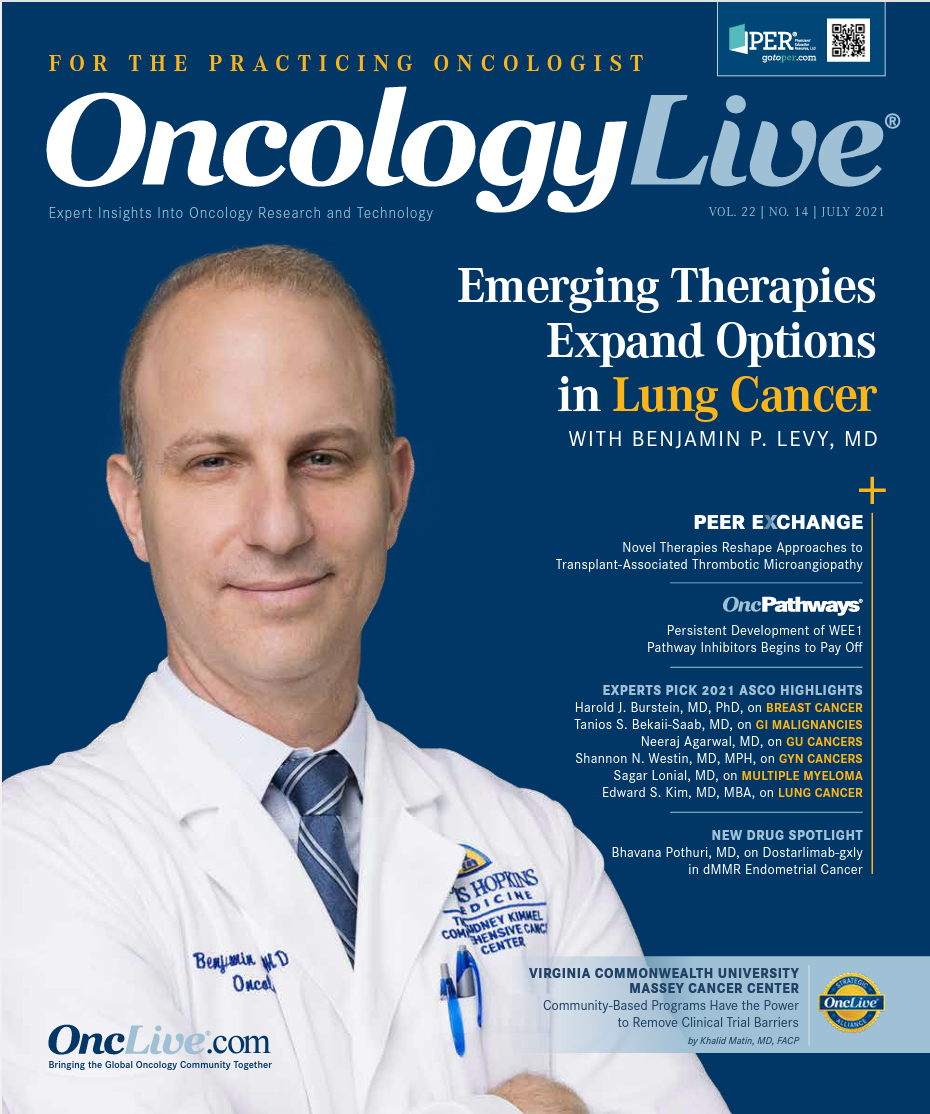Publication
Article
Oncology Live®
Persistent Development of WEE1 Pathway Inhibitors Begins to Pay Off
Author(s):
The lead novel candidate, the WEE1 inhibitor adavosertib, has been tested in more than 50 completed or ongoing clinical studies but has yet to proceed to a phase 3 trial despite showing promising safety and efficacy as monotherapy and in combination with a range of other cancer therapies.

WEE1 is a key regulator of the cell cycle that has been a target of cancer drug discovery efforts for more than a decade. The lead novel candidate, the WEE1 inhibitor adavosertib (AZD1775), has been tested in more than 50 completed or ongoing clinical studies but has yet to proceed to a phase 3 trial despite showing promising safety and efficacy as monotherapy and in combination with a range of other cancer therapies.1,2
Now, however, adavosertib may have found its niche. Results from the first randomized phase 2 clinical trials in patients with ovarian cancer have emerged. Adavosertib in combination with chemotherapy demonstrated encouraging activity both in patients with platinum-resistant or -refractory high-grade serous ovarian cancer (HGSOC) and in those with platinum-sensitive TP53-mutant ovarian, fallopian tube, or primary peritoneal cancer compared with placebo plus chemotherapy.3,4 Findings from several other phase 2 clinical trials have demonstrated the potential of adavosertib in uterine serous carcinoma,5,6 pediatric neuroblastoma,7,8 and solid tumors amplified by CCNE1, the gene encoding cyclin E1.9 Positive results in CCNE1-amplified malignancies highlight the need for biomarkers to identify patients most likely to respond to WEE1 inhibition. Meanwhile, 2 novel highly selective WEE1 inhibitors, IMP7068 and Debio 0123, recently entered clinical testing and investigational therapies directed at kinases that regulate WEE1 activity have become promising drug targets (Table). Most notably, these targets include the ATR protein, a master regulator of the DNA damage response (DDR) pathway that acts to stabilize, protect, and coordinate replication forks.1 Numerous ATR inhibitors have entered clinical development, several of which recently demonstrated encouraging activity in patients with lung and ovarian cancers.1,10-12
Table. Select WEE1 Pathway Inhibitors in Clinical Developmenta

An Achilles Heel
The DDR pathway, a network of hundreds of proteins that detect and respond to DNA damage, and the cell cycle are highly interconnected cellular processes, and many components of both are dysregulated in cancer cells to sustain their hallmark capacity for limitless cell division.13,14
Too much DNA damage is catastrophic, even for cancer cells, and requires a delicate balance in disabling enough DNA repair mechanisms to permit oncogenic alterations while avoiding triggering cell death. As a result, cancer cells can become heavily reliant on certain DNA repair pathways and cell cycle checkpoints, creating a potentially therapeutically tractable Achilles heel.1,14,15
WEE1, a kinase that serves as a molecular sentry at the G2-M checkpoint in the cell cycle, is one such target. In the presence of DNA damage, WEE1 blocks entry into mitosis by “switching off” the CDK1/cyclin B complex that would normally signal to the cell to proceed beyond this point.1,15,16
In normal cells, WEE1 acts as a tumor suppressor by preventing cells from passing on damaged DNA when they divide. The role of WEE1 in tumor cells is not fully understood and although reduced WEE1 expression has been observed in several tumor types, WEE1 also has been shown to be frequently overexpressed, which researchers have postulated is because tumor cells are dependent upon the G2-M checkpoint to maintain tolerable levels of genome instability.17
First-In-Class WEE1 Inhibitor
Despite substantial interest in the idea of targeting WEE1, the development of WEE1 inhibitors to date has been essentially limited to adavosertib. Research began back in 2009, and since then, many clinical trials have evaluated adavosertib as both a single agent and in combination with chemotherapy and other drugs designed to induce DNA damage.1,15-17
The strategy for targeting WEE1 and DNA networks is based on a strong biological rationale and findings from preclinical studies suggesting that WEE1 inhibition has a synthetic lethal effect, whereby the combination of 2 defective genes is lethal to a cell but defects in either one alone is not. There was particular excitement surrounding the potential for WEE1 inhibition to target TP53-mutant cells, the most commonly mutated gene in cancer cells and one that remains stubbornly therapeutically intractable.18 However, the jury is still out on the correlation between TP53 status and clinical benefit from WEE1 inhibition.1,15
Adavosertib was well tolerated but showed limited efficacy as monotherapy, so the focus of clinical development shifted predominantly to combination therapy.1,17 In a number of advanced solid tumors, the combination of adavosertib and platinum-based chemotherapy and/or radiation therapy was shown to be effective.
Clinical development of adavosertib has progressed slowly, however, and data from randomized phase 2 clinical trials are just beginning to emerge. These results have reinvigorated enthusiasm for WEE1 inhibitors.
Adavosertib Trial Findings
In a double-blind, randomized, placebo- controlled phase 2 trial (NCT02151292), 94 women with recurrent/platinum- resistant/refractory HGSOC received adavosertib (175 mg on days 1, 2, 8, 9, 15, and 16) in combination with gemcitabine (1000 mg/m2 on days 1, 8, and 15) in 28-day cycles or placebo plus gemcitabine.3
The addition of adavosertib to gemcitabine yielded a statistically significant improvement in median progression-free survival (PFS), the primary end point of the study, to 4.6 months (95% CI, 3.6-6.4) compared with 3.0 months (95% CI, 1.8-3.8) with placebo (HR, 0.55; 95% CI, 0.35-0.90; log rank P = .015).
The secondary end point of median overall survival (OS) also showed an advantage with the combination. In the final analysis, median OS was 11.4 months (95% CI, 8.2-16.5 months) among patients treated with adavosertib plus gemcitabine and 7.2 months (95% CI, 5.2-13.2 months) among those in the placebo arm (HR, 0.56; P = .017).3 There was also an improvement in the proportion of patients who experienced confirmed partial responses (PRs) according to RECIST version 1.1 (23% vs 6%, respectively; P = .038), with a median duration of response (DOR) of 3.7 months (interquartile range, 3.5-9.6).
The benefit of adavosertib came at the expense of increased toxicity, with more frequent grade 3/4 neutropenia (62% vs 30%), decreased white blood cell counts (54% vs 18%), and thrombocytopenia (31% vs 6%) in the adavosertib arm vs the placebo group, respectively, but there were no treatment-related deaths. Investigators said the hematologic effects were consistent with prior study findings and “generally manageable” with intermittent dose modifications.3
In a second randomized phase 2 trial (NCT01357161), patients with platinum- sensitive ovarian cancer with TP53 mutations were randomized to receive adavosertib (225 mg twice daily for days 1 and 2, and then on the morning of day 3) concomitantly with paclitaxel (175 mg/m2) and carboplatin (area under the curve of 5) on day 1 in 21-day cycles (n = 59) or placebo plus paclitaxel and carboplatin (n = 60).4
The adavosertib-containing regimen was shown to be superior to the placebo-controlled combination in terms of enhanced PFS (ePFS), defined as progression according to changes in tumor volume rather than longest diameter. The median ePFS was 7.9 months (95% CI, 6.9-9.9 months) compared with 7.3 months (95% CI, 5.6-8.2 months), which translated to a 37% reduction in the risk of progression or death (HR, 0.63; 95% CI, 0.38-1.06; P = .080). Per RECIST version 1.1, the overall response rate (ORR) was 66.1% (95% CI, 52.6%-77.9%) in the adavosertib arm and 51.6% (95% CI, 38.6%-64.5%) in the placebo arm (P = .11).4
The addition of adavosertib led to an increase in diarrhea (75% vs 37%), vomiting (63% vs 27%), and anemia (53% vs 32%), respectively, compared with placebo, as well as an increase in the overall incidence of grade 3 and higher AEs (78% vs 65%).4
Beyond Ovarian Cancer
Adavosertib also has started to generate enthusiasm as a treatment for patients with uterine serous carcinoma, an aggressive and challenging form of endometrial cancer that has also been shown to display frequent dysregulation of cell cycle components.5,6 In a single-arm, 2-stage phase 2 study (NCT03668340), the results of which were published in the Journal of Clinical Oncology in March, 34 women who had undergone a median of 3 prior lines of therapy received adavosertib 300 mg once daily for the first 5 days and then on days 8 to 12 in 21-day cycles.5
With a median follow-up of 5.9 months, the ORR was 29.4% (95% CI, 15.1%-47.5%), with 1 confirmed complete response (CR), 8 confirmed PRs, and 1 unconfirmed PR, with a median DOR of 9.0 months (95% CI, 5.5-not available). Median PFS was 6.1 months (95% CI, 4.2-9.9 months).
Hematologic adverse effects (AEs) were common, including grade 3 and above anemia, neutropenia, and thrombocytopenia in 23.5%, 17.6%, and 32.4% of patients, respectively, and common nonhematologic AEs included diarrhea (76.5%), fatigue (64.7%), and nausea (61.8%). Biomarker analyses were performed, but no specific molecular alterations were found to be associated with clinical outcomes.5
Adavosertib in combination with irinotecan also recently showed promise in a cohort of patients with pediatric neuroblastoma enrolled in the phase 2 dose-expansion portion of an ongoing phase 1/2 clinical trial (ADVL1312; NCT02095132). During dose escalation, 27 evaluable patients received adavosertib in combination with irinotecan in 5 different dose cohorts on days 1 to 5 of 21-day cycles. Dose-limiting toxicities, which were observed at a dose of 110 mg adavosertib plus 90 mg/m2/day irinotecan, consisted of 2 patients with grade 3 dehydration and 1 each with diarrhea and hypotension. A patient with Ewing sarcoma had a confirmed PR for 5 cycles and 2 patients, 1 with neuroblastoma and 1 with ependymoma, had prolonged stable disease (SD) for 6 or more cycles.7
In the dose-expansion phase, patients in 3 pediatric disease-specific cohorts (neuroblastoma, medulloblastoma, and rhabdomyosarcoma) received the recommended phase 2 dose of 85 mg/m2 of oral adavosertib plus 90 mg/m2/day of irinotecan for 5 days of every 21-day cycle.
Results presented at the American Association for Cancer Research Annual Meeting 2021 (AACR 2021) detailed 3 objective responses among 20 eligible patients with neuroblastoma, including 1 CR, 1 measurable PR, and 1 marrow-evaluable PR. Three patients also experienced prolonged SD of 8, 11, and 13 cycles. Investigators said only 1 patient had a dose-limiting toxicity, which was managed with a dose reduction.8
Additionally, of 9 patients with predicted a deficiency of ATRX, a chromatin remodeler associated with poor outcomes in some neuroblastoma subtypes,19 4 (44%) had objective responses or prolonged SD, suggesting a potential biomarker that warrants further investigation.8
Meanwhile, a phase 2 trial in patients with CCNE1 amplification (NCT03253679) reinforced preclinical studies that suggested that tumors with this molecular alteration are highly sensitive to WEE1 inhibition, according to findings presented at AACR 2021.9
Among 27 evaluable patients with 12 tumor types who had received a median of 4 prior lines of therapy over a median follow-up of 11.7 months, there were 7 confirmed PRs for an ORR of 25.9% (95% CI, 15.1%-47.5%), including 5 patients with HGSOC, and an additional 8 patients with HGSOC had SD for 6 months or longer.
Grade 3 and higher AEs included neutropenia, thrombocytopenia, anemia, nausea, diarrhea, and fatigue.9 Trial recruitment has been suspended pending a protocol amendment required for expansion, according to information posted on ClinicalTrials.gov.20
Adavosertib targets 8 kinases, in addition to WEE1, albeit with lower potency, but there is still room to improve upon its selectivity.21 Two novel, more selective WEE1 kinase inhibitors have recently entered clinical development. Impact Therapeutics, based in China, is developing IMP7068 and was recently granted permission by the Chinese National Medical Products Administration to begin phase 1 trials.22 Debio 0123 was initially developed by Almac Discovery and subsequently licensed by Debiopharm,23 which has begun a f irst-in-human clinical trial of Debio 0123 in combination with carboplatin in patients with advanced solid tumors (NCT03968653).
ATR and CHK1 as Targets
In addition to WEE1 inhibitors, drugs targeting ATR and CHK1, which sit upstream of WEE1 in the DDR pathway, are also being developed. CHK1 inhibitors have struggled with tolerability1 and only prexasertib (LY2606368) is currently in clinical testing. Eli Lilly and Company reportedly dropped development of prexasertib in 2019 and the drug is not currently listed in the company’s oncology pipeline.24,25 However, several clinical trials are listed as active according to ClinicalTrials.gov, sponsored by various research institutions, with Eli Lilly and Company listed as a collaborator.26
ATR inhibitors have proven much more promising, and multiple such drugs have rapidly entered clinical trials.1 The most widely studied are berzosertib (M6620) and ceralasertib (AZD6738). Berzosertib has been shown to be well tolerated in combination with different chemotherapy regimens in patients with advanced solid tumors.27,28
Phase 2 data in patients with HGSOC and small cell lung cancer (SCLC) were recently reported. Among 25 patients with SCLC, berzosertib plus topotecan resulted in an ORR of 36%, including durable regressions in patients with platinum-resistant disease.10 A randomized phase 2 trial of this combination is currently ongoing (DDRiver SCLC 250; NCT04768296).
In a randomized phase 2 study of berzosertib plus gemcitabine compared with gemcitabine alone in patients with platinum-resistant HGSOC, the median PFS was 22.9 weeks (90% CI, 17.9-72 weeks) in the combination arm compared with 14.7 weeks (90% CI, 9.7-36.7 weeks) in the gemcitabine monotherapy arm (HR, 0.57; 90% CI, 0.33-0.98; P = .044).11
In the ongoing phase 2, biomarker-directed HUDSON umbrella study (NCT03334617) in patients with non–small cell lung cancer, a combination of ceralasertib and the PD-L1 inhibitor durvalumab (Imfinzi) in patients with ATM mutations (n = 18) elicited an ORR of 13.3%, 6-month PFS of 61.2%, and 6-month OS of 100%.12
References
- Gorecki L, Andrs M, Korabecny J. Clinical candidates targeting the ATR-CHK1-WEE1 axis in cancer. Cancers (Basel). 2021;13(4):795. doi:10.3390/cancers13040795
- AZD-1775. ClinicalTrials.gov. Accessed June 14, 2021. https://www.clinicaltrials.gov/ct2/results/details?term=AZD-1775
- Lheureux S, Cristea MC, Bruce JP, et al. Adavosertib plus gemcitabine for platinum-resistant or platinum-refractory recurrent ovarian cancer: a double-blind, randomised, placebo-controlled, phase 2 trial. Lancet. 2021;397(10271):281-292. doi:10.1016/S0140-6736(20)32554-X
- Oza AM, Estevez-Diz M, Grischke E-M, et al. A biomarker-enriched, randomized phase II trial of adavosertib (AZD1775) plus paclitaxel and carboplatin for women with platinum-sensitive TP53-mutant ovarian cancer. Clin Cancer Res. 2020;26(18):4767-4776. doi:10.1158/1078-0432.CCR-20-0219
- Liu JF, Xiong N, Campos SM, et al. Phase II study of the WEE1 inhibitor adavosertib in recurrent uterine serous carcinoma. J Clin Oncol. 2021;39(14):1531-1539. doi:10.1200/JCO.20.03167
- Madariaga A, Oza AM. Wee1 inhibition in recurrent serous uterine cancer: science paving the way in a challenging disease. J Clin Oncol. 2021;39(14):1513-1517. doi:10.1200/JCO.21.00288
- Cole KA, Pal S, Kudgus RA, et al. Phase I clinical trial of the Wee1 inhibitor adavosertib (AZD1775) with irinotecan in children with relapsed solid tumors: a COG phase 1 consortium report (ADVL1312). Clin Cancer Res. 2020;26(6):1213-1219. doi:10.1158/1078-0432.CCR-19-3470
- Cole K, Ijaz H, Surrey L, et al. Pediatric phase 2 trial of the WEE1 inhibitor adavosertib (AZD1775) and irinotecan: a Children’s Oncology Group Study (ADVL1312). Presented at: American Association for Cancer Research Annual Meeting 2021; April 9-14, 2021; virtual. Accessed June 14, 2021. https://www.abstractsonline.com/pp8/#!/9325/presentation/5158
- Fu S, Yao S, Yuan Y, et al. Phase II trial of the Wee1 inhibitor adavosertib in advanced refractory solid tumors with CCNE1 amplification. Presented at: American Association for Cancer Research Annual Meeting 2021; April 9-14, 2021; virtual. Accessed June 14, 2021. https://www.abstractsonline.com/pp8/#!/9325/presentation/2061
- Thomas A, Takahashi N, Rajapakse VN, et al. Therapeutic targeting of ATR yields durable regressions in small cell lung cancers with high replication stress. Cancer Cell. 2021;39(4):566-579.e7. doi:10.1016/j.ccell.2021.02.014
- Konstantinopoulos PA, Cheng S-C, Wahner Hendrickson AE, et al. Berzosertib plus gemcitabine versus gemcitabine alone in platinum-resistant high-grade serous ovarian cancer: a multicentre, open-label, randomised, phase 2 trial. Lancet Oncol. 2020;21(7):957-968. doi:10.1016/S1470-2045(20)30180-7
- Besse B, Awad M, Forde P, et al. HUDSON: an open-label, multi-drug, biomarker-directed, phase II platform study in patients with NSCLC, who progressed on anti-PD(L)1 therapy. J Thorac Oncol. 2021;16(suppl 3):S118-S119. doi:10.1016/j.jtho.2021.01.299
- Hanahan D, Weinberg RA. Hallmarks of cancer: the next generation. Cell. 2011;144(5):646-674. doi:10.1016/j.cell.2011.02.013
- O’Connor MJ. Targeting the DNA damage response in cancer. Mol Cell. 2015;60(4):547-560. doi:10.1016/j.molcel.2015.10.040
- Geenen JJJ, Schellens JHM. Molecular pathways: targeting the protein kinase Wee1 in cancer. Clin Cancer Res. 2017;23(16):4540-4544. doi:10.1158/1078-0432.CCR-17-0520
- Matheson CJ, Backos DS, Reigan P. Targeting WEE1 kinase in cancer. Trends Pharmacol Sci. 2016;37(10):872-881. doi:10.1016/j.tips.2016.06.006
- Ghelli Luserna di Rorà A, Cerchione C, Martinelli G, Simonetti G. A WEE1 family business: regulation of mitosis, cancer progression, and therapeutic target. J Hematol Oncol. 2020;13(1):126. doi:10.1186/s13045-020-00959-2
- Kogan S, Carpizo D. Pharmacological targeting of mutant p53. Transl Cancer Res. 2016;5(6):698-706. doi:10.21037/tcr.2016.11.74
- Cook A, Bernstein E. A strike against indolent neuroblastoma. EBioMedicine. 2020; 60:103000. doi:10.1016/j.ebiom.2020.103000
- AZD1775 in treating patients with advanced refractory solid tumors with CCNE1 amplification. ClinicalTrials.gov. Updated April 20, 2021. Accessed June 29. 2021. https://bit.ly/3y6nKXD
- Elbæk CR, Petrosius V, Sørensen CS. WEE1 kinase limits CDK activities to safeguard DNA replication and mitotic entry. Mutat Res. 2020;819-820:111694. doi:10.1016/j.mrfmmm.2020.111694
- Impact Therapeutics announced the IND approval for its Wee1 inhibitor IMP7068 from the NMPA. News release. Impact Therapeutics. February 9, 2021. Accessed June 13, 2021. https://en.impacttherapeutics.com/news/hy/67.html
- Debio 0123. Debiopharm. Accessed June 13, 2021. https://www.debiopharm.com/pipeline/debio-0123/
- Al Idrus A. Lilly dumps phase 2 cancer drugs that survived previous cull. Fierce Biotech. April 30, 2019. Accessed June 12, 2021. https://www.fiercebiotech.com/biotech/lilly-dumps-phase-2-cancer-drugs-survived-previous-cull
- Oncology pipeline. Lilly Oncology. Updated April 27, 2021. Accessed June 29, 2021. https://bit.ly/3x5EH4B
- Prexasertib. ClinicalTrials.gov. Accessed June 29, 2021. https://bit.ly/3y5Ukc7
- Middleton MR, Dean E, Evans TRJ, et al. Phase 1 study of the ATR inhibitor berzosertib (formerly M6620, VX-970) combined with gemcitabine ± cisplatin in patients with advanced solid tumours. Br J Cancer. Published online May 26, 2021. doi:10.1038/s41416-021-01405-x
- Shapiro GI, Wesolowski R, Devoe C, et al. Phase 1 study of the ATR inhibitor berzosertib in combination with cisplatin in patients with advanced solid tumours. Br J Cancer. Published online May 26, 2021. doi:10.1038/s41416-021-01406-w










